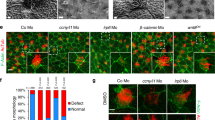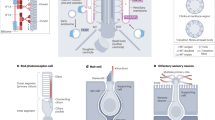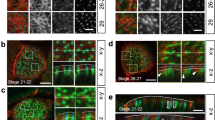Abstract
Ciliated epithelia produce fluid flow in many organ systems, ranging from the respiratory tract where it clears mucus1 to the ventricles of the brain where it transports cerebrospinal fluid2. Human diseases that disable ciliary flow, such as primary ciliary dyskinesia, can compromise organ function or the ability to resist pathogens, resulting in recurring respiratory infections, otitis, hydrocephaly and infertility3. To create a ciliary flow, the cilia within each cell need to be polarized coordinately along the planar axis of the epithelium, but how polarity is established in any ciliated epithelia is not known. Here we analyse the developmental mechanisms that polarize cilia, using the ciliated cells in the developing Xenopus larval skin as a model system4. We show that cilia acquire polarity through a sequence of events, beginning with a polar bias set by tissue patterning, followed by a refinement phase. Our results indicate that during refinement, fluid flow is both necessary and sufficient in determining cilia polarity. These findings reveal a novel mechanism in which tissue patterning coupled with fluid flow act in a positive feedback loop to direct the planar polarity of cilia.
This is a preview of subscription content, access via your institution
Access options
Subscribe to this journal
Receive 51 print issues and online access
$199.00 per year
only $3.90 per issue
Buy this article
- Purchase on Springer Link
- Instant access to full article PDF
Prices may be subject to local taxes which are calculated during checkout





Similar content being viewed by others
References
Afzelius, B. A. Cilia-related diseases. J. Pathol. 204, 470–477 (2004)
Sawamoto, K. et al. New neurons follow the flow of cerebrospinal fluid in the adult brain. Science 311, 629–632 (2006)
Zariwala, M. A., Knowles, M. R. & Omran, H. Genetic defects in ciliary structure and function. Annu. Rev. Physiol. 69, 423–450 (2006)
Assheton, R. Notes on the ciliation of the ectoderm of amphibian embryos. Q. J. Microscope Sci. 38, 465–484 (1896)
Twitty, V. C. Experimental studies on the ciliary action of amphibian embryos. J. Exp. Zool. 50, 310–344 (1928)
Woerdeman, M. W, Entwicklungsmechnanische Untersuchungen uber die Wimperbewegung des Ectoderms von Amphibienlarven. Rouxs Arch. Dev. Biol. 106, 41–61 (1925)
Tung, T. C. & Tung, Y.-F. Y. Experimental studies on the determination of polarity of ciliary action in anuran embryos. Arch. Biol. (Liege) 51, 203–218 (1940)
Frisch, D. & Farbman, A. I. Development of order during ciliogenesis. Anat. Rec. 162, 221–232 (1968)
Konig, G. & Hausen, P. Planar polarity in the ciliated epidermis of Xenopus embryos. Dev. Biol. 160, 355–368 (1993)
Roomans, G. M., Ivanovs, A., Shebani, E. B. & Johannesson, M. Transmission electron microscopy in the diagnosis of primary ciliary dyskinesia. Ups. J. Med. Sci. 111, 155–168 (2006)
Nasevicius, A. & Ekker, S. C. Effective targeted gene 'knockdown' in zebrafish. Nature Genet. 26, 216–220 (2000)
Sapiro, R. et al. Male infertility, impaired sperm motility, and hydrocephalus in mice deficient in sperm-associated antigen 6. Mol. Cell. Biol. 22, 6298–6305 (2002)
Tanaka, H. et al. Mice deficient in the axonemal protein Tektin-t exhibit male infertility and immotile-cilium syndrome due to impaired inner arm dynein function. Mol. Cell. Biol. 24, 7958–7964 (2004)
Frangos, J. A., Eskin, S. G., McIntire, L. V. & Ives, C. L. Flow effects on prostacyclin production by cultured human endothelial cells. Science 227, 1477–1479 (1985)
Hsu, P. P. et al. Effects of flow patterns on endothelial cell migration into a zone of mechanical denudation. Biochem. Biophys. Res. Commun. 285, 751–759 (2001)
Witzgall, R. New developments in the field of cystic kidney diseases. Curr. Mol. Med. 5, 455–465 (2005)
Bush, A. et al. Primary ciliary dyskinesia: diagnosis and standards of care. Eur. Respir. J. 12, 982–988 (1998)
Sive, H., Grainger, R. M. & Harland, R. M. The Early Development of Xenopus laevis: a Laboratory Manual (Cold Spring Harbor Press, Plainview, New York, 1998).
Davidson, L. A., Hoffstrom, B. G., Keller, R. & DeSimone, D. W. Mesendoderm extension and mantle closure in Xenopus laevis gastrulation: combined roles for integrin alpha(5)beta(1), fibronectin, and tissue geometry. Dev. Biol. 242, 109–129 (2002)
Nieuwkoop, P. D. & Faber, J. Normal Table of Xenopus laevis (North Holland, Amersterdam, 1967)
Chien, S. in The Red Blood Cell (ed. Surgenor, M. D.) 1031–1133 (Academic Press, New York, 1975)
Acknowledgements
We thank members of the laboratory for critical comments on the manuscript. We are grateful to C. Stevens and M. Dickinson for discussions. This work was supported by a NIH grant to C.K.
Author information
Authors and Affiliations
Corresponding author
Ethics declarations
Competing interests
Reprints and permissions information is available at www.nature.com/reprints. The authors declare no competing financial interests.
Supplementary information
Supplementary Information
This file contains Supplementary Figure S1 and Supplementary Table S1 with Legends and Supplementary Videos S1-S6 Legends. (PDF 1731 kb)
Supplementary Video S1
This file contains Supplementary Video S1 which shows fluid flow produced by a stage 16 explant. (MOV 417 kb)
Supplementary Video S2
This file contains Supplementary Video S2 which shows fluid flow produced by a St10 explant (MOV 266 kb)
Supplementary Video S3
This file contains Supplementary Video S3 which shows fluid flow produced by a st29 embryo injected with a control morpholino (MOV 319 kb)
Supplementary Video S4
This file contains Supplementary Video S4 which shows loss of fluid flow in TEKT2AMO/BMO injected embryos. (MOV 351 kb)
Supplementary Video S5
This file contains Supplementary Video S5 which shows visualization of cilia beating in individual ciliated cells and the loss of cilia motility in morphants. (MOV 2087 kb)
Supplementary Video S6
This file contains Supplementary Video S6 which shows St10 explant tested at St29 after treatment with 0.5 Dyn/cm2 of shear stress. (MOV 338 kb)
Rights and permissions
About this article
Cite this article
Mitchell, B., Jacobs, R., Li, J. et al. A positive feedback mechanism governs the polarity and motion of motile cilia. Nature 447, 97–101 (2007). https://doi.org/10.1038/nature05771
Received:
Accepted:
Published:
Issue Date:
DOI: https://doi.org/10.1038/nature05771
This article is cited by
-
Dual-color live imaging unveils stepwise organization of multiple basal body arrays by cytoskeletons
EMBO Reports (2024)
-
Microridge-like structures anchor motile cilia
Nature Communications (2022)
-
Hydrodynamic model of directional ciliary-beat organization in human airways
Scientific Reports (2020)
-
Multi-scale spatial heterogeneity enhances particle clearance in airway ciliary arrays
Nature Physics (2020)
-
Active mucus–cilia hydrodynamic coupling drives self-organization of human bronchial epithelium
Nature Physics (2020)
Comments
By submitting a comment you agree to abide by our Terms and Community Guidelines. If you find something abusive or that does not comply with our terms or guidelines please flag it as inappropriate.



